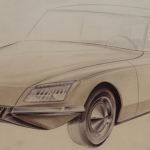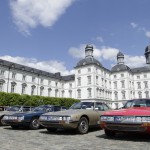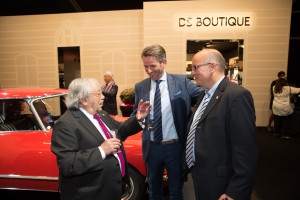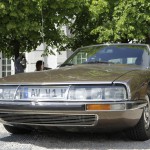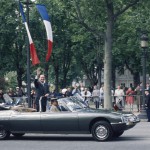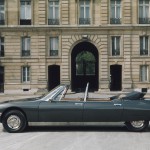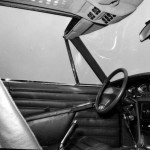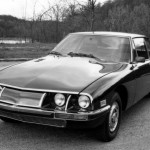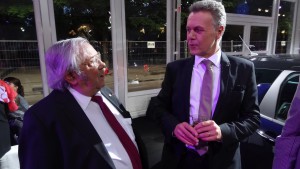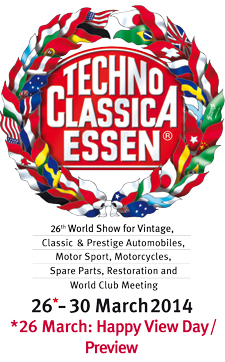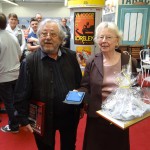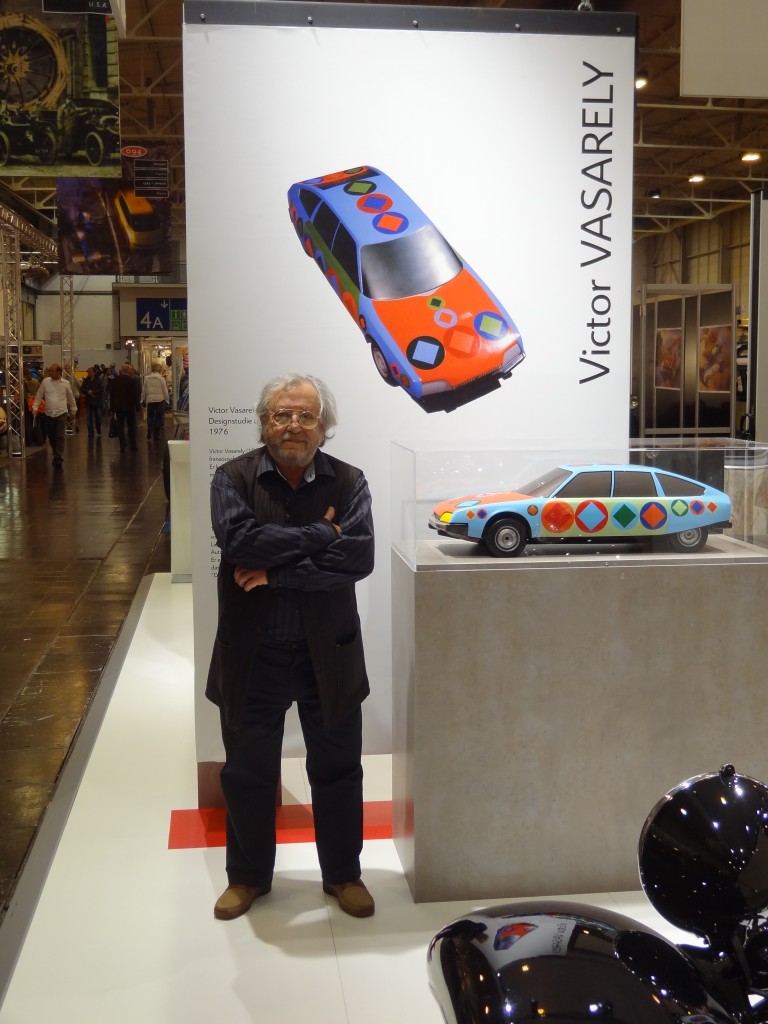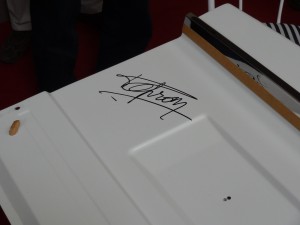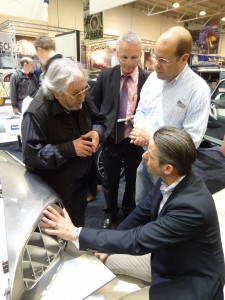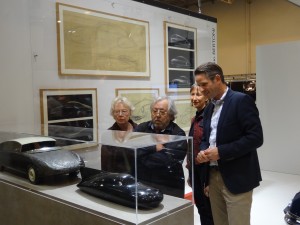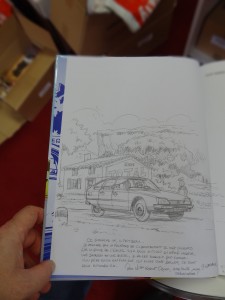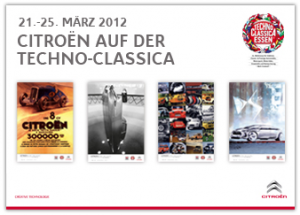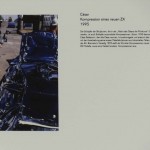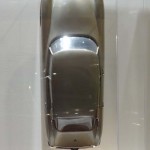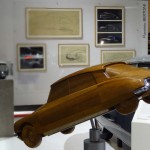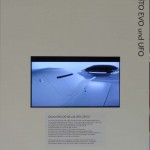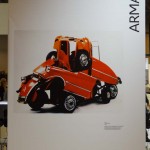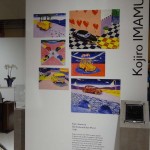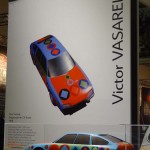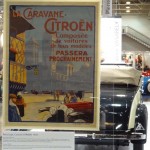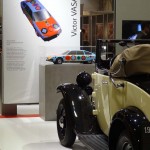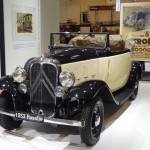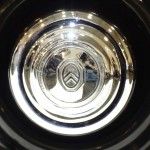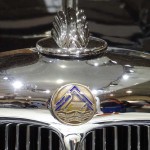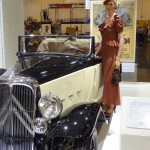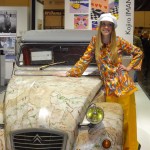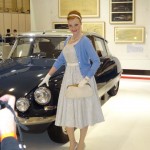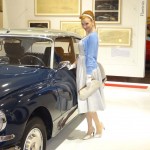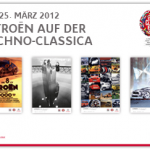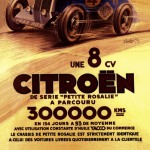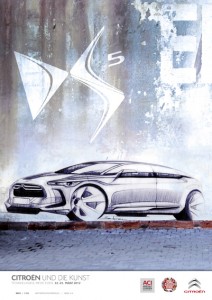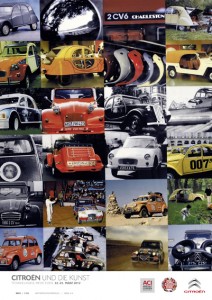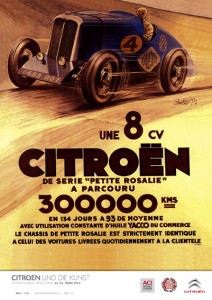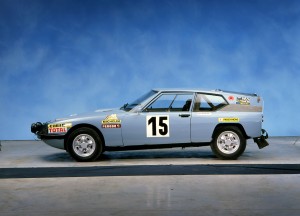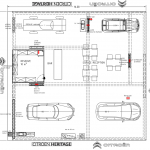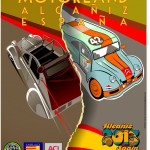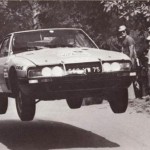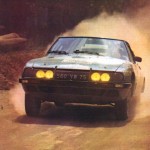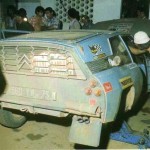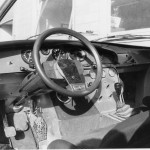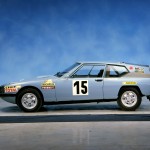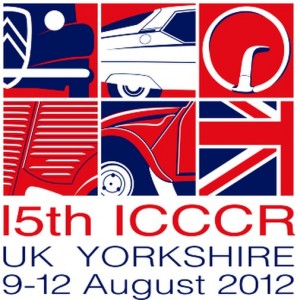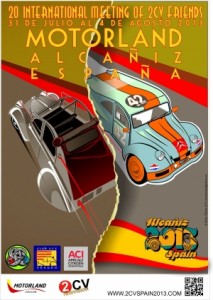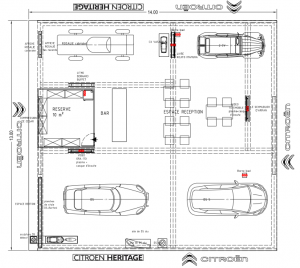
(english below, en francais au-dessous)
Leider hat einer der großen Kreativköpfe dieser Welt viel zu früh unseren Planeten verlassen – wir trauern um Robert Opron, der am 29. März 2021 von uns gegangen ist.
Vielen ist Robert Opron durch seine automobilen Kreationen, die die große Epoche von Citroën in den 1960er und 1970er Jahren geprägt haben, bekannt: die Restylings des 2CV und der DS nach 1964, die Dyane, der Ami 8, der Wankel-M35, der CX, GS, und nicht zuletzt das herausragende SM-Coupé haben Maßstäbe in allen Segmenten gesetzt, durch die Automobiles Citroën nicht nur gerade im Volumensegment große Verkaufserfolge erzielen konnte, sondern die auch Meilensteine in der heute als “Space Age” benannten Ära geworden sind. Alle Modelle sind Design-Klassiker geworden, und sind aus Standardwerken über die Geschichte der Marke nicht wegzudenken – und CX, GS und SM haben in den letzten Jahren erhebliche Wertsteigerungen verzeichnen können wie kaum andere Modelle ihrer Zeit aus ihrem Marktsegment.Selbst beim Citroën 350 Bus und am 1974 erschienenen C35 war Opron involviert, bevor er nach 12 Jahren bei Citroën im 1974 zu Renault wechselte: unter anderem beim Renault 9, 11, 25, Supercinq, Fuego und Rodeo 5, der Vesta Prototyp, Renault Espace und Express, bis hin zum Alpine V6 hat er seine Spuren hinterlassen. Als sein besonderes Designmerkmal wird sicherlich die gewölbte Heckscheibe (auf frz. “hayon bulle”) in die Geschichte eingehen, die SM, Fuego, R11, R25 und Alpine V6 stilistisch verbinden. Aus seiner Arbeit als unabhängiger Berater ab den 1990er Jahren tragen u.a. Ligier Optima, Ambra und Dué seine Gene.
2000 endete seine berufliche Laufbahn, die er als Designer 1959 mit dem Simca Fulgur begonnen hatte und 1992 nach 6 Jahren bei Fiat beendete. Er transportierte die Kreativität seines Vorgängers bei Citroën, dem legendären Flaminio Bertoni, in die neue Ära und mit seiner eigenen Handschrift weiter. Peter Pijlman zählt in seiner lesenswerten Biographie “Robert Opron – L’Automobile et L’Art” allein 72 (!) erschienene Modelle seines Stils auf…! Und von den tausenden Entwürfen, die es nie auf die große Bühne geschafft haben, ganz zu schweigen.Der 1932 geborene Robert Opron ist stets ein Kreativ-Genie geblieben, auch nachdem er in den Ruhestand – oder sollte man besser “Unruhestand” sagen – wechselte. Einige von uns haben ihn auch in den letzten Jahren sehen und bei der ein oder anderen Gelegenheit treffen können. Zwar war er in seiner physischen Beweglichkeit eingeschränkt – aber sein Geist war stets wach und immer auf der Suche nach der ultimativen Form eines Automobils, das zwischen Stil, Bequemlichkeit, Moderne und auch Nutzbarkeit geprägt war: es war für ihn immer ein Fortbewegungsmittel für den Menschen, der im Zentrum der schöpferischen Kraft stand, und nicht des puren Designs wegen, und erst recht nicht wegen einer Auffälligkeit oder gar zum Zweck des “Posing”.
In Deutschland und insbesondere auf der Technoclassica haben wir ihn mehrfach als Ehrengast der Ausstellergemeinschaft “Citroën-Strasse” begrüßen dürfen, und 2012 dann auch als Ehrenmitglied ausgezeichnet – zugleich wurde er auch Ehrenmitglied im Citroën SM Club Deutschland e.V., und später dann auch im CX Club. Er war stets in Begleitung seiner Frau Geneviève, die ihm nicht nur zur Seite stand, sondern auch ihm den Freiraum verschafft hat, in dem er seine Ideen weiter verfolgen konnte – frei nach dem Motto: “Hinter jedem großen Mann steht eine starke Frau”.
Sein Weg über die Technoclassica war stets anders als bei vielen anderen Besuchern – er studierte. Er “las” die ausgestellten Fahrzeuge, die Maquettes, die Designstudien: die Silhouetten, die Stilelemente und Linienzüge, zumeist die Designs und Entwürfe, die seine Epoche ausmachten, bis hin zu den ausgestellten Modellen der Neuzeit. Man konnte ihn dabei beobachten, die Formen zu spüren, die Oberflächen zu ertasten und zu fühlen. Der Blick allein reichte nicht.
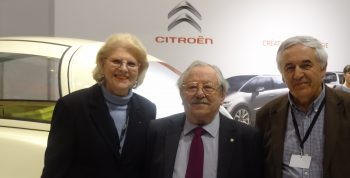
Einige Größen seiner Zeit: Marlène Wolgensinger-Cotton, Robert Opron, Jean-Paul Cardinal, vor C10 Prototyp, Retromobile Paris 2014
Robert Oprons letzter öffentlicher Auftritt datiert aus dem 100jährigen Jubiläum der Marke Citroën – den “Centenaire” in La Ferté-Vidame, 2019. In einem gemeinsamen Interview mit Patrick André (u.a. verantwortlich für die “Expo Bertoni”) und Stéphane Bonutto (dt. Delegation der “Assoziazione Flaminio Bertoni”), beides Freunde der Familie, lieferte er seine Erinnerungen über Flaminio Bertoni und erklärte seine Arbeit als Chefdesigner bei Citroën als keinesfalls eine Kopie oder Weiterführung der Arbeit von Bertoni, sondern als den Ausdruck seiner persönlichen Auffassung des Automobildesigns.
Stephan Joest: “Zuletzt habe ich Robert und Geneviève Opron unmittelbar vor Eintreffen der Pandemie im Februar 2020 getroffen. Wir waren anschließend noch beim Abendessen in einem kleinen Pariser Vorort, zusammen mit Rosemarie Gumz, der engsten Freundin der beiden. Auch wenn die Gesundheit ein wenig nachließ, blitzten seine Augen oft verschmitzt und fast schon jungenhaft auf, wenn man mit ihm über die ein oder andere Kreation diskutierte, und es ihm die Gelegenheit gab, seine Sicht der Dinge kurz, knapp, und dennoch “au point” wiederzugeben.”
Robert Opron war stets ein Mann der leisen Töne, kein Mensch für die große Bühne oder die großen Worte. Seine Garage war zuletzt die Welt, in der er die meiste freie Zeit verbrachte, und dort an einem kleinen Tisch skizzierte und studierte, und es war die Welt von Bleistift, Papier, Entwürfen, Denken, und nicht zuletzt: Kreativität.
Stéphane Bonutto war ebenfalls im Winter 2019/20 zu Gast bei dem Ehepaar Opron gewesen und machte eine ähnliche Erfahrung: “Nachdem Robert aus seinem frühabendlichen Schlaf zu Tisch gekommen war, sagte er zwar zunächst, daß seine Arbeit bei Citroën der weiten Vergangenheit gehören würde, und ihn nicht mehr so sehr interessiere. Bei der Erwähnung von Flaminio Bertoni blühte er jedoch regelrecht auf, und peu-à-peu fielen ihm zahlreichen Erinnerungen aus dieser Zeit ein. Besonders wurde ich von der schlichten Schönheit seiner Sätze beeindruckt – ausgesuchte Worte und Gedankengänge, welche den tiefen Versteher der Ästhetik, der Form und der Kunst kennzeichnen. Auf meine Frage, wie für ihn eine ideale automobile Form aussehe, antworte er: “eine Form, welche die Kraft in ausgewogener Art und Weise auf die Räder überträgt”.
Leider hat auch ihn die Pandemie eingeholt. Wie so viele in diesen Tagen ist er nun in einer anderen Welt angekommen. Wir wünschen uns, und sind uns sicher, dass er dort mindestens so kreativ ist wie auf dieser. Denn so wollen wir ihn dort eines Tages treffen…!
Unsere stille Anteilnahme übermitteln wir an Geneviève Opron, seine Kinder, Enkel und Urenkel, sowie an alle Angehörigen.
Stephane Bonutto und Stephan Joest,
auch im Namen der deutschen Citroën-Clubs.
Nachtrag:
die englische Version des Textes wird auch auf der internationalen Homepage der ACI, www.amicale-citroen-internationale.org veröffentlicht werden. Dort wird die Kommentarfunktion freigeschaltet sein – so können dort Beileidsbekundungen hinterlassen werden.
—–
In Memoriam: Robert Opron
Sadly, one of the world’s great creative minds has left our planet far too soon – we mourn the passing of Robert Opron on March 29, 2021.
To many, Robert Opron is known for his automotive creations that marked the great era of Citroën in the 1960s and 1970s: the restylings of the 2CV and the DS after 1964, the Dyane, the Ami 8, the Wankel-M35, the CX, GS, and last but not least the outstanding SM coupé have set standards in all segments, through which Automobiles Citroën not only achieved great sales success at the “volume segment”: these vehicles also became milestones in the era now named the “Space Age”. All models are renowned design classics, and are indispensable in standard works on the history of the brand – and CX, GS and SM have seen significant increases in value in recent years like few other models of their time, and from their market segment.Opron was even involved in the Citroën 350 Bus and the C35, which appeared in 1974, before moving to Renault in 1974 after 12 years with Citroën: he left his mark on the Renault 9, 11, 25, Supercinq, Fuego and Rodeo 5, the Vesta prototype, Renault Espace and Express, and even the Alpine V6. The curved rear window (in French “hayon bulle”) will certainly go down in history as his special design feature, stylistically linking the SM, Fuego, R11, R25 and Alpine V6. From his work as an independent consultant from the 1990s, Ligier Optima, Ambra and Dué, among others, carry his genes.
2000 marked the end of his professional career, which he had begun as a designer in 1959 with the Simca Fulgur and ended in 1992 after 6 years at Fiat. He transported the creativity of his predecessor at Citroën, the legendary Flaminio Bertoni, into the new era and continued with his own signature. In his “Style Opron” biography, which is well worth reading, Peter Pijlman lists 72 (!) published models of his style alone in his remarkable biography “Robert Opron – L’Automobile et L’Art”…! And not to mention the thousands of designs that never made it to the big stage.
Born in 1932, Robert Opron has always remained a creative genius, even after he retired – or should we say “unretired”. Some of us have also been able to see him in recent years and meet him on one occasion or another. It is true that he was limited in his physical mobility – but his mind was always awake and always looking for the ultimate form of an automobile, marked between style, comfort, modernity and also usability: for him it was always a means of transportation for humans, who was at the center of the creative force, and not for the sake of pure design, and certainly not for any flashiness or even for the purpose of “posing”.
In Germany, and especially at the Technoclassica, we have been able to welcome him several times as an honorary guest of the exhibitors’ association “Citroën-Strasse”, and then in 2012 he was also honored as an honorary member – at the same time he became an honorary member of the Citroën SM Club Deutschland e.V., and later also of the CX Club. He was always accompanied by his wife Geneviève, who not only stood by his side, but also provided him with the space in which he could pursue his ideas further – freely following the motto: “Behind every great man is a strong woman”.
His path through Technoclassica was always different from that of many other visitors – he studied. He “read” the vehicles on display, the maquettes, the design studies: the silhouettes, the stylistic elements and lines, mostly the designs and blueprints that defined his era, right up to the modern-day models on display. He could be seen sensing the shapes, feeling and touching the surfaces. The view alone was not enough.
Perhaps an anecdote could be related, said Stephan Joest: “I remember accompanying him at one of the classic car shows. We were standing in front of an SM Opéra, i.e. the 4-door variant of the original 2-door car, which had been created by another independent coachbuilder. When I asked Robert to pose briefly for a photo in front of this car, he became quite indignant, forbidding even one shot to be taken.” His explanation was short but to the point – this car was not only stylistically not beautiful, but even a “design outrage” as he said, and he certainly did not want to be associated with it. His interpretation of the SM’s mission was realized in the best possible way in the production model!
Robert Opron’s last public appearance dates from the Citroën brand’s 100th anniversary – the “Centenaire” in La Ferté-Vidame, 2019. In a joint interview with Patrick André and Stéphane Bonutto, he provided his recollections about Flaminio Bertoni and explained his work as chief designer at Citroën as in no way a copy or continuation of Bertoni’s work, but rather the expression of his personal view of automotive design.
I last met Robert and Geneviève Opron just days before the pandemic arrived. We were having dinner afterwards in a small Paris suburb, together with Rosemarie Gumz, a close friend of theirs. Even though his health was declining a bit, his eyes often flashed mischievously, almost boyishly when discussing one creation or another with him, and it gave him the opportunity to give his view of things briefly, succinctly, and yet “au point.”
Robert Opron was always a man of quiet tones, not a man for the big stage or the big words. His garage was latterly the world in which he spent most of his free time, crafting, sketching and studying there at a small table, and it was the world of pencil, paper, designing, thinking, and last but not least: creativity.
Stéphane had also been a guest of the Opron couple in the winter of 2019/20, and had a similar experience: “After Robert came to the table from his early evening sleep, he admittedly said at first that his work at Citroën belonged to the distant past, and didn’t interest him that much anymore. At the mention of Flaminio Bertoni, however, he really blossomed, and peu-à-peu numerous memories from that time came to his mind. I was particularly struck by the simple beauty of his sentences – choice words and trains of thought that characterize the profound understander of aesthetics, form, and art. When I asked him what an ideal automobile shape looked like to him, he replied: “a shape that transmits power to the wheels in a balanced way”.
Unfortunately, the pandemic has caught up with him, too. Like so many these days, he has now arrived in another world. We wish that he is at least as creative there as he is on this one. Because that’s how we want to meet him there one day…!
Our deepest condolences are with his wife and his children, grandchildren and greatgrandchildren, and all other members of his family.
Stephane Bonutto and Stephan Joest,
also on behalf of the German Citroën clubs.
NB – this English version will also be published on the international homepage of the ACI, www.amicale-citroen-internationale.org. There the comment function is enabled – so your condolences can be submitted there.
—–
Le Décès de Robert Opron
Un des grands créateurs de notre temps vient de nous quitter bien trop tôt – c’est avec une profonde tristesse que nous vous faisons part du décès de Robert Opron survenu le 29 mars 2021.
Qui ne connait pas Robert Opron pour ses créations automobiles, qui ont marqué la grande époque de Citroën dans les années 1960-1970 : à commencer par les restylages de la 2CV et la DS après 1964, suivis de la Dyane, l’Ami 8, la M35 à moteur Wankel, la CX, la GS et, non des moindres, le phénoménal coupé SM. Non seulement ces automobiles ont été des succès commerciaux pour Citroën, elles sont de surcroit des jalons historiques d’une époque appelé aujourd’hui « l’âge de la conquête de l’espace ». Tous ces modèles sont devenus des classiques de style et font partie intégrante des standards de la Marque – les CX, GS et SM ont vu durant ces dernières années leur valeur augmenter comme aucun autre modèle de leurs catégories respectives. Robert Opron fut même impliqué dans la genèse des Citroën 350 bus et C35, avant de quitter Citroën en 1974 après 12 années d’engagement envers la Marque, pour entrer chez Renault. R9, R11, R25, Supercinq, Fuego et Rodeo 5, prototype Vesta, Espace et Express, sans oublier l’Alpine V6 portent son empreinte. Le « hayon bulle » entrera certainement dans l’histoire de l’automobile comme la signature stylistique de Robert Opron et réunit SM, Fuego, R11, R25 et Alpine V6 autour d’un trait commun. Les Ligier Optima, Ambra et Dué portent les gènes de son travail comme consultant indépendant dans les années 1990. En 2000, Robert Opron mit un terme à une carrière professionnelle commencée en 1959 avec la Simca Fulgur et conclue chez un constructeur en 1992 après 6 années passées chez Fiat. Il transporta la créativité de son prédécesseur chez Citroën, le légendaire Flaminio Bertoni, dans une nouvelle ère, avec son style propre. Dans son excellent ouvrage biographique appelé à juste titre «Robert Opron – L’Automobile et L’Art», Peter Pijlman ne recense pas moins de 72 modèles automobiles porteurs de son trait de crayon !
Né en 1932, Robert Opron a été durant toute sa carrière un génie créatif, et le fut également après son départ en retraîte, que l’on devrait d’ailleurs plutôt qualifier de départ vers d’autres activités. Nombre d’entre nous ont pu le voir ou le rencontrer personnellement lors de l’une ou l’autre occasion. Bien que restreint dans sa mobilité physique ces derniers temps, son esprit était toujours alerte et à la recherche de la forme ultimative d’une automobile empreinte de style, confort, modernité et utilité : la voiture fut toujours pour lui, non pas un pur objet de design et encore moins un faire-valoir tapageur, mais un moyen de transport pour un être humain situé au centre d’une force créatrice.
Nous avons eu la joie d’accueillir Robert Opron à plusieurs reprises en tant qu’invité d’honneur de la « rue Citroën » sur la Technoclassica et de lui remettre en 2012 son titre de membre d’honneur. Il fut dernièrement également déclaré membre d’honneur du Club Citroën SM d’Allemagne, et après aussi du club CX. Robert était toujours accompagné de son épouse Geneviève, qui non seulement l’épaulait, mais lui laissait aussi son espace créatif suivant le proverbe « derrière chaque grand homme se trouve une non moins grande femme. Robert Opron parcourait l’exposition de la Technoclassica de façon différente de celle des autres visiteurs. Il « lisait » les voitures exposées, les maquettes, les études de design : leurs silhouettes, leurs éléments de style et leurs lignes, surtout en ce qui concerne les modèles qui marquèrent leur temps. On pouvait le voir ressentir les formes et appréhender les surfaces. Le regard seul ne lui suffisait pas.
Relatons ici une anecdote, dit Stephan Joest: « Je me rappelle avoir accompagné Robert Opron sur un salon de voitures classiques. Nous étions devant une SM Opéra, donc une variante à 4 portes du coupé original émanant d’un carrossier indépendant. Alors que je le priais de poser pour une photo devant la voiture, il devint visiblement gêné et refusa la moindre prise de vue. » Son explication fut brève mais claire – il ne trouvait pas la voiture belle d’un point de vue du style, mais la qualifiait de surcroît de sacrilège et refusait d’y être associé. Son interprétation de la SM était réalisée de manière inaltérable dans le modèle de série !
La dernière apparition publique de Robert Opron date du Centenaire Citroën à La Ferté-Vidame en 2019. Au cours d’une interview commune avec Patrick André et Stéphane Bonutto, il livra au public ses souvenirs sur Flaminio Bertoni et expliqua son travail en tant que directeur du style chez Citroën comme n’étant en aucun cas une copie ou une continuation du travail de Bertoni, mais bien comme son expression personnelle du design automobile.
Stephan dit: « J’ai eu la chance de revoir Robert Opron peu avant le début de la pandémie. Nous nous retrouvâmes pour un dîner dans une petite ville de la région parisienne, avec Geneviève et Rosemarie, une amie des plus proches du couple. Nonobstant sa santé quelque peu déclinante, ses yeux devenaient malicieux voire juvéniles lorsque nous parlions de l’une ou l’autre création et que l’occasion se présentait pour lui de livrer son opinion, de manière concise mais toujours ‘au point’ ».
Robert Opron était un homme au verbe discret et non un homme de scène ou un tribun. Ces derniers temps, son garage était l’univers dans lequel il passait la plupart de son temps libre à dessiner ou étudier, c’était un monde de crayons, papiers, croquis, pensées et aussi surtout : de créativité.
Stéphane (Bonutto) eut également la joie de passer une soirée chez le couple Opron durant l’hiver 2019-2020 et fit une expérience comparable : « Après avoir fini son sommeil de début de soirée et être venu nous rejoindre à table, il commença par me déclarer que son travail chez Citroën appartenait au passé et ne l’intéressait désormais plus vraiment. L’évocation de Flaminio Bertoni le fit retrouver une énergie grandissante, et de nombreux souvenirs de cette époque lui revinrent peu à peu à l’esprit. Je fus particulièrement impressionné par la beauté de son élocution – des pensées et des mots choisis qui révèlent un sens profond de l’esthétique, de la forme et de l’art. A ma question sur la forme idéale d’une automobile, il me formula cette réponse : « une forme équilibrée, dans la transmission de la puissance au roues. »
Malheureusement la pandémie l’a emporté lui aussi. Comme bien d’autres par ces temps-ci, il est désormais arrivé dans un autre monde. Nous souhaitons – et en sommes convaincus – qu’il y soit au moins aussi créatif qu’il le fut dans ce monde-ci. C’est dans cet esprit que nous voulons l’y retrouver un jour…!
Nous adressons toutes nos condoléances et exprimons notre amitié la plus sincère à G.O., leurs enfants, petits-enfants et arrière-petits-enfants.
Stephan Joest et Stéphane Bonutto, aussi dans le nom des clubs Citroën d’Allemagne.
PS: La version anglaise du texte sera également publiée sur la page d’accueil internationale l’ACI, www.amicale-citroen-internationale.org et la fonction de commentaire y sera activée – vous pourrez donc y enregistrer vos condoléances.


